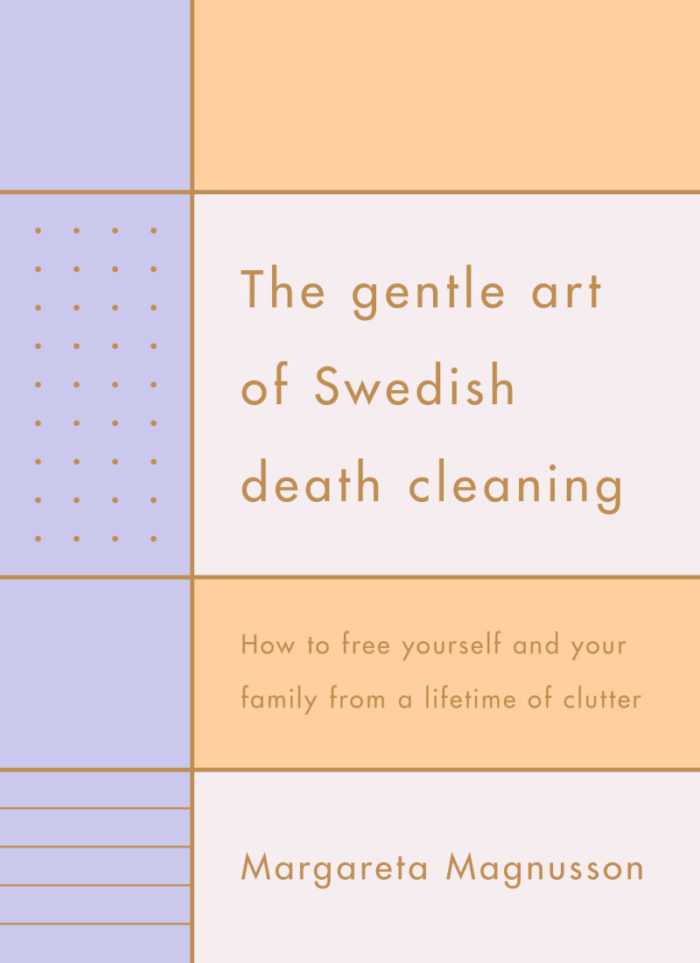There’s no doubt that Marie Kondo revolutionized our relationship with our stuff. She’s been a major player in the modern day minimalist movement adored by those living clutter-free across the ages. (If you have no idea who I’m talking about, where you been? Go here.) But there’s a new kid on the block; a Swede by the name of Margareta Magnusson and she advocates consuming with death in mind. Let me explain. It’s really not as scary as it sounds…
Magnusson encourages us to look at our belongings with one simple thought in mind: what burden is x,y, or z going to place upon our loved ones once we’ve gone? Morbid, right? But see, that’s the point. She places emphasis on our mortality and explains why it’s important to consider the fact that life is temporary when it comes to our consumption habits. What’s going to stand the test of time? What truly matters?
Published earlier this month, Magnusson’s book, The Gentle Art of Swedish Death Cleaning, talks readers through the process of decluttering in a way that I’ve not seen done before. Instead of looking at decluttering as a personal and–technically–selfish process to better one’s own wellbeing, death cleaning is done with a greater perspective in mind. It looks at how our things live on once we die–their immortality and place in this world once we’re no longer physically able to possess them. Someone has to deal with your stuff once you’ve crossed over to the other side. How do you want that experience to be for them? Thought-provoking, isn’t it?

Magnusson, a lady-boss ‘aged between 80 and 100,’ is an artist who’s moved 17 times in her life. This book came from an experience she had when her husband passed away and she was forced to down-size her home. She suddenly had to think about all of the things around her and what they meant to her now that she was entering this entirely new phase of life. The death of a loved one is always a haunting reminder of our mortality. She set to work assessing exactly this and her book talks readers through doing the same, placing focus on the joys of life rather than the sorrows of death.
It’s an interesting perspective, if you think about it; this whole death cleaning thing. And an environmentally-friendly one too. I know a lot of minimalists that–as well as liking the clean aesthetic that this lifestyle brings–approach having fewer possessions from an environmental perspective. Questioning every purchase prior to making it and being conscious of your material possessions naturally means that only the best of the best make the cut into what you keep. It’s no secret that we’re plagued with an obsession for shopping. Well, consuming in general, really. And the result is that we don’t really value all the stuff we bring into our lives. This disposable culture does terrible things to our wallets and the environment, so gaining some perspective could be exactly what the doctor ordered en masse.

I bet if you stopped and asked every deal-finding shopaholic to take the time and energy to really assess their possessions, they’d tell you that it isn’t really the stuff that matters to them. No, rather it’s the process. Obsessive shopping is a symptom of unhappiness that can result in a heavy cloud of debt looming overhead as well as the burden of overwhelming quantities of clutter. Saying no to doing things this way means that you aren’t clouded by all the stuff. You are surrounded with only what matters, what lifts you up and reflects–accurately–who you are and where you are in life at this present time.
Combine sparking joy à la Marie Kondo with Magnusson’s wisdom of death cleaning, and set yourself up for healing, self-expression and a positive environment for your mind. Minimalism forces you to get in touch with yourself and your mental health, looking for ways of healing that go directly to the source rather than skirt around it. Plus, it’s easy to make the transition once you’ve got a few pointers and can be applied to static life as well as the regular traveler.
So, really it all comes down to you taking the time to question the kind of footprint you leave on this Earth when it’s time to say goodbye. It’s one step further than simply having a sleek apartment for the next few years. What happens after that? You don’t want to be remembered for all of that stuff you hoarded, do you? Didn’t think so.
How do you want to be remembered? Which of your possessions are most important to you?
—
Photo: Jon Flobrant on Unsplash; via Unsplash




